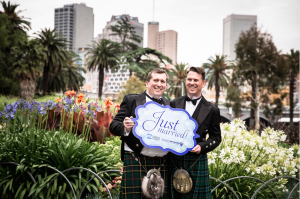Marriage equality (Scotland)
In Scotland the campaign for equal marriage was organised by The Equality Network.[1]
Contents
Petition and consultation
In January 2009 Nick Henderson, director of the LGBT Network, submitted a petition to the Scottish Parliament, calling for a change in the law to allow two people of the same sex from getting married, by amending the Marriage (Scotland) Act 1977. The petition also called for allowing same-sex marriage ceremonies to be performed by faith groups, with the consent of the religious institution in question.[2][3]
The Scottish Government held a consultation exercise starting on the 2nd of September 2011,[4] six months ahead of that in England and Wales. The consultation closed on the 9th of December.[5] In the final count there were 77,508 responses, including 14,779 from outside Scotland. Including postcard and petition response, 64% of those who responded said they were against same-sex marriage. However excluding postcard and petition responses to the consultation from within Scotland, 65% were in favour and 35% against.[6] This is consistent with a poll in June 2012 which revealed that 64 per cent of Scots support equal marriage.[7]
On 25 July 2012 the Scottish Government announced that it would introduce equal marriage, together with religious ceremonies for civil partnerships. The bill would be accompanied by safeguards (which were likely to need UK legislation) to assure the religious freedom of groups or individuals opposed to gay marriage.[8]
In December 2012 a draft bill was published for consultation.[9] In May 2013 it was announced that a bill would be introduced within the current session of the Scottish Parliament, with the first weddings possibly as early as 2014.[10]
Marriage and Civil Partnerships Act (Scotland) 2014
The Marriage and Civil Partnerships Bill (Scotland) was introduced in the Scottish Parliament on 27 June 2013.[11] It was different in a few respects from the bill for England and Wales, in particular no religious bodies would be barred from conducting same-sex weddings if they wished to, and there was provision for Humanist weddings.[12]
On 20 November 2013 the bill passed Stage 1 with by 98 votes to 15 with 5 abstentions.[13]
Stage 2 (during which the Bill is subjected to detailed scrutiny) concluded on the 16th of January 2014. Four major amendments were passed during Stage 2, all of them increasing the difference between the English and Scottish versions:
- Removing the spousal veto on gender recognition
- Allowing the option of gender-neutral marriage ceremonies
- Introducing simpler gender recognition evidence requirements for long-term transitioned people
- Allowing people who have registered a civil partnership in a foreign country to change that to a marriage in Scotland.
The final Stage 3 vote took place on the 4th of February 2014. The bill was passed by 105 votes to 18. It received the royal assent on 13th March.
It was originally hoped that the first weddings could take place in October, but by mid-April it appeared that the date had slipped back towards the end of 2014.[14]
The Act finally came into force on 16 December 2014, enabling couples to convert their civil partnerships to marriage, or to give 15 days notice of their intention to marry. The first couple to make use of the new law were Douglas Pretsell and Peter Gloster, who converted their Scottish civil partnership to marriage at the British Consulate in Melbourne, Australia as soon as the law came into effect at one minute past midnight.[15] The first actual marriages could take place on Hogmany (31 December 2014).[16]
Church attitudes
In June 2017 the Scottish Episcopal Church voted to allow same-sex marriages to take place in church, in contrast to the Church of England which is prohibited by law from conducting same-sex weddings, and in opposition to the policy of the worldwide Anglican Communion.[17] Meanwhile the Church of Scotland is considering the issue.
References
- ↑ Equal Marriage Campaign (Scotland). (Archived at 30/01/2018.)
- ↑ "Same-sex marriage supporters to petition Scottish Parliament" Pink News 13 January 2009
- ↑ "Same Sex Marriage Ban Must Be Lifted, Say Scottish Gays" UK Gay News 13 January 2009
- ↑ "The Registration of Civil Partnerships Same Sex Marriage - A Consultation"
- ↑ "Consultation sees 50,000 responses", The Scotsman, 10 December 2011.
- ↑ "Gay marriage to be introduced in Scotland", BBC News, 25 July 2012.
- ↑ "Poll: Record 64 percent support for equal marriage in Scotland". PinkNews, 17 June 2012.
- ↑ Katrine Bussey, Hilary Duncanson, "Scotland's gay marriage law to progress", The Independent, 25 July 2012.
- ↑ Gay marriage: Draft bill launched in Scotland", BBC News, 12 December 2012.
- ↑ "Scotland's gay marriage bill to come before Holyrood within a month", BBC News, 28 May 2013.
- ↑ "Scotland's gay marriage bill published at Holyrood", BBC News, 27 June 2013.
- ↑ Severin Carrell, "Scotland's gay marriage bill published, with more freedoms for celebrants", The Guardian, 27 June 2013
- ↑ "Equal marriage bill overwhelmingly passes Stage 1 Debate in Scottish Parliament" Pink News, 20 November 2013.
- ↑ Judith Duffy, "No gay wedding bells until Christmas", Herald Scotland, 13 April 2014.
- ↑ Dan Littauer, "First Scottish gay couple becomes married", Kaleidoscot, 16 December 2014.
- ↑ "Equal marriage legal in Scotland", Equality Network. (archived as at 19 February 2015.)
- ↑ Harriet Sherman, Scottish Anglican church faces sanctions over vote to allow same-sex marriage, The Guardian, 27 September 2017.

